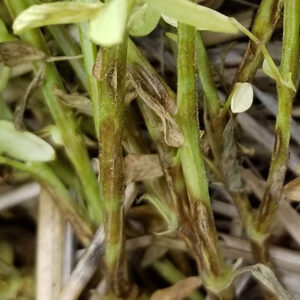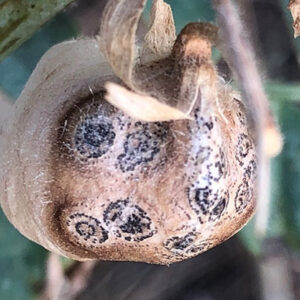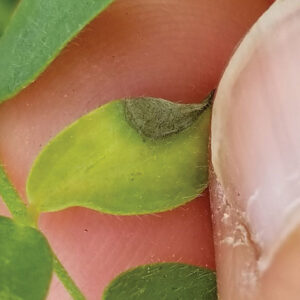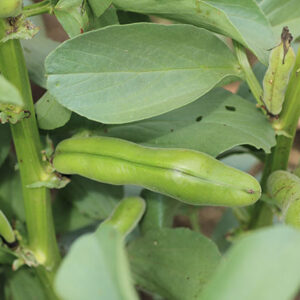
Features
Fungicides
Pulses
Fungicide insensitivity in pulses
Understanding and managing this serious issue for Prairie pulse crops.
March 6, 2024 By Carolyn King
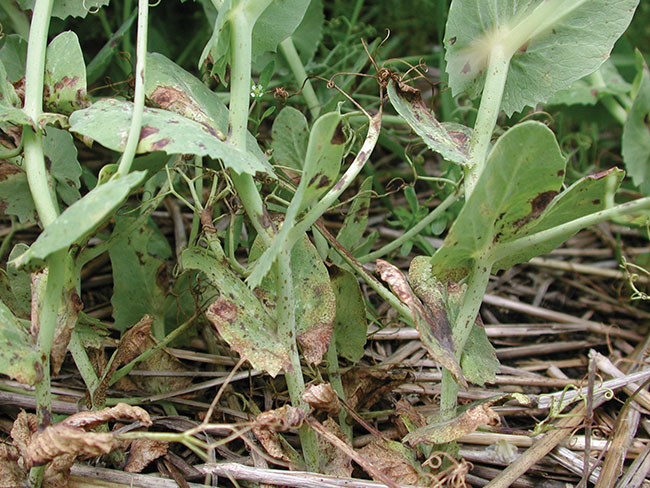 The second Group 11 insensitivity problem discovered in Saskatchewan was in mycosphaerella blight of field pea.
Photo courtesy of Saskatchewan Pulse Growers
The second Group 11 insensitivity problem discovered in Saskatchewan was in mycosphaerella blight of field pea.
Photo courtesy of Saskatchewan Pulse Growers Fungicides are valuable tools for crop production, but the development of fungicide insensitivity (resistance) in a crop pathogen can blunt or even destroy a fungicide’s effectiveness. Over the past two decades, fungicide insensitivity has been documented in three important pulse diseases on the Prairies. The latest problem was first reported in 2019.
However, this insensitivity issue need not continue to increase. Pulse growers now have good options for managing these insensitive pathogen populations and for extending the longevity of fungicide actives.
About the problem
“Fungicide insensitivity is a problem in the major foliar diseases in our pulse crops: ascochyta blight in chickpea, anthracnose of lentil and mycosphaerella blight in pea,” notes Michelle Hubbard, a pulse pathologist with Agriculture and Agri-Food Canada (AAFC).
The pathogens involved are: Ascochyta rabiei causing chickpea ascochyta blight, Colletotrichum lentis causing lentil anthracnose and Mycosphaerella pinodes causing mycosphaerella blight in field pea.
For all three pathogens, widespread insensitivity to all strobilurin actives, the Group 11 fungicides, has been confirmed on the Prairies.
The risk of fungicide insensitivity is influenced by the fungicide, the pathogen and agronomic factors, as well as weather conditions that favor disease development.
“One of the biggest factors affecting insensitivity risk is fungicide selection pressure. Historically, the Group 11 actives have been the mainstay for disease control in our pulse crops. That pattern of using Group 11s over and over has been occurring not only in pulses but also in canola, wheat, and other common crops on Prairie farms, and has led to increased selection pressure on the pathogens,” says Meagen Reed, an agronomy manager with the Saskatchewan Pulse Growers (SPG).
“Fungicide groups that dominate use in our pulse crops are Groups 11, 7 and 3. Most products are a combination of two or three of those. But the strobilurins are still commonly the base in these combinations.”
In addition to the high use pattern for the strobilurins, they are also at high risk for insensitivity because they act on a single target site in the pathogen. With a single gene mutation, called G143A, a pathogen gains a high level of insensitivity to all Group 11 actives.
Each of the three pathogens with documented Group 11 insensitivity has some characteristics that make them prone to developing fungicide insensitivity.
For instance, all three are polycyclic, meaning that they have multiple life cycles in one growing season. That increases the likelihood that several fungicide applications may be needed in a single season to control the disease.
AAFC plant pathologist Bruce Gossen also notes that Ascochyta rabiei and Mycosphaerella pinodes produce wind-blown spores that can spread the pathogen, including any insensitive biotypes, for long distances.
As well, Ascochyta rabiei and Mycosphaerella pinodes each have a sexual reproduction phase. Sexual reproduction generates greater genetic diversity than asexual reproduction. This increased diversity increases the likelihood that some of the individuals in the pathogen’s population may have a mutation that makes them insensitive to a fungicide. Repeated use of that fungicide will select for the insensitive individuals because they can survive the fungicide applications and reproduce, becoming a larger part of the pathogen’s population with each generation.
“So, we have this perfect storm of high use patterns for a fungicide at high risk of insensitivity and polycyclic pathogens capable of adapting quickly,” says Reed. “And some growers in some parts of the province have tighter rotations, growing their pulse crop every one-in-two or one-in-three years. And we are seeing two or three applications of fungicides in lentils in some areas, and up to four to six applications in chickpea. That is a lot of selection pressure.”
Although fungicide insensitivity in Prairie pulses is a serious concern, Gossen puts it in perspective: “We have a chance to learn from other places in Canada and the world where fungicide insensitivity is a much bigger issue. And these days, we have effective approaches to disease management in pulses and effective fungicides. As long as we are managing in a smart way, we needn’t have problems with fungicide insensitivity in our pulse crops.”
Chickpea ascochyta insensitivity
The first fungicide insensitivity issue reported in Prairie pulse crops was for ascochyta blight in chickpea, the most serious chickpea disease in Saskatchewan. The problem developed remarkably quickly.
In 2003, Group 11s were introduced in western Canada. In 2004, Gossen’s research team detected Group 11 insensitivity in a few Ascochyta rabiei isolates from Saskatchewan. Then a 2006 survey confirmed this insensitivity in several chickpea fields in the province. By 2007 to 2008, his team found that almost all isolates were insensitive to the Group 11s.
“Ascochyta blight in chickpea sometimes needs three or four fungicide applications, and back then we had only one really effective fungicide for that. So, we saw a very rapid increase in fungicide insensitivity in Saskatchewan,” Gossen explains.
More recently, Hubbard led a survey of Ascochyta rabiei insensitivity in Saskatchewan commercial chickpea fields in 2019, and then did some insensitivity testing as part of her 2022 trial looking at fungicide use in different chickpea varieties.
When Hubbard and her research team found ascochyta blight on chickpea plants in these two studies, they used a PCR-based test to check for the G143A mutation in the isolates to see which ones were insensitive to all Group 11 actives.
“We found that insensitivity to Group 11s is very common in Ascochyta rabiei in chickpea,” says Hubbard. For example, in the 2019 survey, Ascochyta rabiei was detected in 33 samples collected from 29 fields (out of a total of 44 fields surveyed). Group 11 insensitive isolates were present in all 33 samples. Only eight also had some Group 11 susceptible isolates.
Hubbard is also investigating intercropping of chickpea with flax as a way to reduce fungicide use when managing chickpea ascochyta. “I’m very excited about intercropping because it does seem to work. My trials date back to 2018. Lana Shaw [research manager for the South East Research Farm] and Bill May [crop management agronomist with AAFC at Indian Head] had done work in previous years,” she says. The most recent project was funded by Saskatchewan’s Agriculture Development Fund (ADF), Western Grains Research Foundation and SaskFlax and led by May.
“The main take-home message from our research on intercropping chickpea with flax is that, if there is disease, then most of the time there is less disease with intercropping, but not no disease.” That finding holds true whether you plant the chickpea in the same row as flax or in a separate row.
In addition, Hubbard is leading a three-year project, which started in 2023, to assess the effects of different fungicide regimes in combination with intercropping chickpea and flax. She wants to see if the use of intercropping can reduce the need for fungicide applications or increase the effectiveness of those applications. As well, she has a trial comparing different flax and chickpea varieties to find out if some varieties are better suited to intercropping than others. This project is funded by ADF and SPG and led by Randy Kutcher at the University of Saskatchewan.
Pea mycosphaerella blight insensitivity
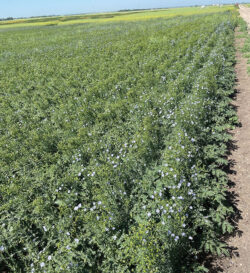
Using integrated disease management strategies, like intercropping chickpea and flax, to manage foliar diseases can help reduce the risk of developing fungicide insensitivity.
A few years after the chickpea ascochyta insensitivity problem was discovered in Saskatchewan, a second fungicide insensitivity issue was found. This time, it was in mycosphaerella blight of field pea, a damaging disease that is common in Prairie pea-growing areas. The disease is actually a complex of several pathogens, but the main fungus in the complex on the Prairies is Mycosphaerella pinodes.
The Group 11 insensitivity in Mycosphaerella pinodes was identified by Gossen and his colleagues. He says, “After seeing the rapid increase in insensitivity in chickpea ascochyta blight, my program got interested in mycosphaerella blight in field pea because Ascochyta rabiei and Mycosphaerella pinodes share many of the same characteristics that increase the risk of fungicide insensitivity. And there was a lot of fungicide use [in the early 2010s] because of grower interest in applying strobilurin fungicides not only to control the disease but also to improve crop health and growth.”
First, the researchers tested the sensitivity of isolates that had been collected in Alberta, Saskatchewan, North Dakota, and Washington State before 2003. All of the isolates were sensitive. Then, they tested samples collected in 2010 and 2011 in the same regions. A small percentage of the isolates from Alberta and Saskatchewan were insensitive; none of the U.S. isolates were insensitive.
Then, when the researchers tested Saskatchewan isolates collected from 2013 to 2016, they found that 72 per cent were insensitive to Group 11s. Gossen adds, “When we looked at the issue again a few years later, the insensitivity had increased up to about 95 per cent.”
Lentil anthracnose insensitivity
Group 11 insensitivity in lentil anthracnose, one of the most important lentil diseases on the Prairies, was first confirmed in Saskatchewan lentil fields in 2019.
Hubbard is currently leading a lentil anthracnose insensitivity project funded by SPG and ADF. Surveys in 2020, 2021 and 2022 collected samples of the disease across much of Saskatchewan’s lentil-growing area. Hubbard’s team tested the Colletotrichum lentis isolates from the samples for the G143A mutation.
“We found that insensitivity to Group 11s is common in Saskatchewan’s lentil production region,” says Hubbard. The majority fields had a mix of sensitive and insensitive isolates, a small percentage of fields had only insensitive isolates and an even smaller percentage had only sensitive isolates.
The project also includes testing of Colletotrichum lentis isolates for insensitivity to Group 7s and Group 3s. Group 7s have a medium to high risk for fungicide insensitivity, and Group 3s have a medium risk.
Hubbard has been collaborating on this project with Gossen. His research team has been helping with some of the project tasks, including testing the Group 7 actives.
“What we have found is encouraging; there is no evidence that there is insensitivity to Group 7s,” she says. They plan to start testing for insensitivity to Group 3s in the next few months.
Reed notes that SPG also funded a 2021 greenhouse study by Insight Plant Health to test the effectiveness of different fungicides for controlling Group 11 insensitive lentil anthracnose. One of the key findings was that Saskatchewan growers should not rely solely on Group 11 actives to control this disease. Details of the findings are available on the SPG website.
Tips for tackling insensitivity
Hubbard, Gossen and Reed all emphasize that having a good break between pulse crops in your crop rotation and having a diverse fungicide rotation are key practices in the battle against fungicide insensitivity.
“Be aware of the fungicide groups and actives you are using, and how often you are using them across the farm, not just in your pulse crops,” says Reed. She recommends using many different modes of action in your fungicide rotation, including tank mixes and products with more than one active, particularly if multiple fungicide applications are needed in a single growing season.
She says, “Also, do not apply Group 11 actives alone, and try to avoid using Group 11 products more than once per season. If you’re using a product with a Group 11, make sure the other active has an effect on your target pathogen.”
“The good news is that a number of new actives and new fungicide groups have been registered on pulses in the last few years. Growers have not only effective fungicides but options for rotating effective fungicides,” says Gossen.
He adds, “The pulse industry has been very successful in attracting research interest from chemical companies to explore what actives are effective and to move those forward. Another really positive thing is the emphasis that the industry is placing on making fungicide products with more than one active, which guards against the rapid development of fungicide insensitivity.”
Reed is excited to see these new product options. She also stresses the importance of applying fungicides according to their label, such as using proper timing, recommended rates and correct water volumes. “Especially with a disease like lentil anthracnose, which typically starts on the lower part of the plant, penetrating the canopy with your spray is really important, and water volumes are critical for that.”
Hubbard offers some tips specifically for chickpea ascochyta and lentil anthracnose. “Assume that any ascochyta on your chickpeas is insensitive to Group 11s. Don’t rely on fungicides that only have a Group 11 active ingredient. Especially consider, later in the season, using a contact-based fungicide that doesn’t have a Group 11 at all. Contact-based modes of action are at even a lower risk of insensitivity than the Group 7s and Group 3s,” she says.
“Similarly for lentil anthracnose, assume that it is insensitive to Group 11s, and don’t rely on fungicides that only have a Group 11. And consider contact-based fungicides, or fungicides that have, say, Group 3 actives without a Group 11.”
Hubbard also recommends, “Use clean seed. And consider choosing some of the new chickpea varieties and pay attention to the ascochyta disease ratings of the varieties.” (At present, commercially available lentil varieties are susceptible to the main race of Colletotrichum lentis on the Prairies.)
As another way to reduce your fungicide use, Hubbard suggests trying intercropping chickpea and flax, perhaps starting with a small area if you’re new to intercropping. In the future, she hopes to assess lentil intercropping as a foliar disease management tool.
And last but not least, Reed, Gossen and Hubbard all underline the importance of scouting for disease and carefully assessing whether a fungicide application is needed. And while you’re scouting, watch for signs of fungicide insensitivity.
Following these best management practices will help keep fungicide insensitivity issues at bay.
